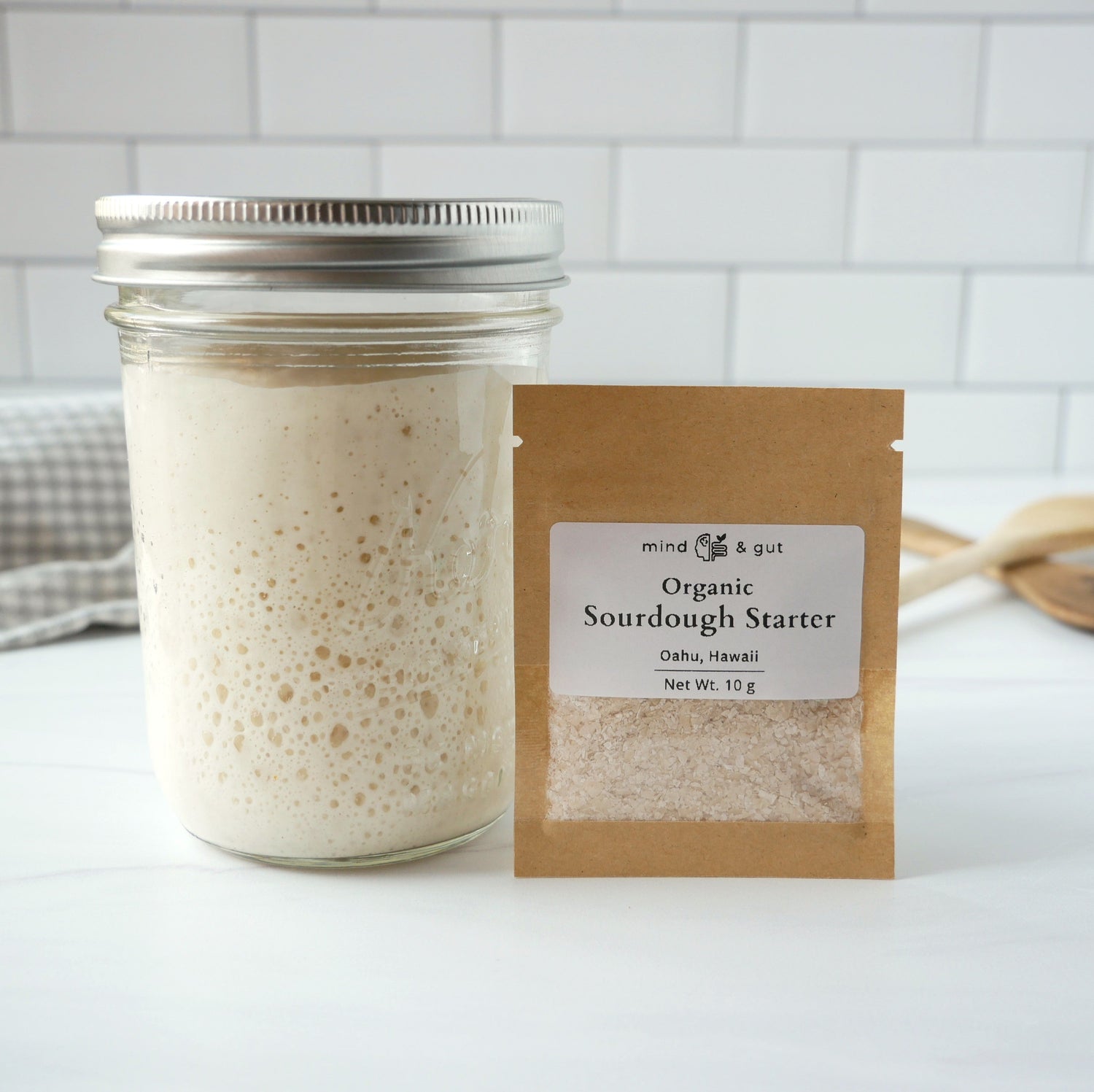Artisan Sourdough Bread Recipe
This is our traditional artisan sourdough bread recipe. First, there is a recipe card with quick steps to reference, and below that are more detailed instructions that explain each step more thoroughly.
Tips
- Use a scale to weigh the ingredients. Tare the scale between each ingredient added.
- Use lukewarm filtered or spring water. Avoid hot or cold water.
- Use a salt that does not have anti-caking agents added if possible. Anti-caking agents can interfere with fermentation.
- Research videos for ‘Slap & Fold + Stretch & Fold’ techniques.
Recipe Card (Quick Steps):
 Artisan Sourdough Bread Recipe70% hydration recipe
Yield: 1 Loaf
Prep Time: 3 hours Bulk Ferment Time: 3-12+ hours Cold Proof Time: 6-36 hours Cook Time: 45 minutes Ingredients300g Water 100g Active Sourdough Starter 450g All-Purpose or Bread Flour 10g Salt Instructions1. Mix Ingredients
2. Stretch & Fold
3. Bulk Rise
4. Pre-Shape
5. Shape and Cold Proof
6. Bake
7. Cool and Slice
Tip: For a softer crust, butter the top of the loaf right after it comes out of the oven. |
More Detailed Instructions:
STEP 1: Combine Ingredients
- Add the water to a mixing bowl. Warm water (not hot) will help activate the starter microbes. Cool water is fine, warm water is better.
- Add the starter and mix to incorporate fully into the water.
- Add flour and salt.
- Gently combine all the ingredients in the bowl until they are fully incorporated and no dry flour remains on the surface of the dough. Do not overwork the dough. It should be shaggy in appearance, sticky and holding together as one dough unit.
- Leave the dough in the bowl and cover with plastic wrap or a damp towel. Let the dough rest for 30 minutes.
STEP 2: Slap & Fold + Stretch & Fold
- Mist the counter and your hands with water to prevent sticking. Turn the dough out from the bowl onto the counter.
- Slap & fold the dough 8 to 10 times. The goal is for the dough to transform into a smooth texture and hold a ball shape. Do not overwork the dough with too many slap & folds beyond 10 or it will begin to lose its elasticity.
- Cover the dough and let the dough rest for 30 minutes.
- After 30 minutes, mist the counter and your hands with water to prevent sticking. Stretch and fold the dough on each of the 4 sides. Roll it over and repeat. The dough should become significantly tighter and resist being stretched. Don’t force it so that you do not tear the dough.
- Cover the dough and let the dough rest for 30 minutes.
- After 30 minutes, mist the counter and your hands with water to prevent sticking. By this third round, it will be more like a fold and roll rather than a stretch & fold because there should be little stretch remaining in the dough.
STEP 3: Bulk Rise
- After the final stretch & fold or roll & fold, lightly oil a food storage container or bowl.
- If using a food storage container, place the dough inside. Then put a rubber band around the container to mark the dough fill line. Place a second rubber band above the first to mark the % rise you're aiming for. See step 4.
- If using a bowl, first remove a sample of the dough and place it in a small and oiled jar. Mark the dough fill line with a rubber band around the jar. Then place the remaining large dough ball into the oiled bowl and cover with a loose lid.
- The bulk rise phase can take as little as 3 hours or as long as 12 hours depending on the temperature of the dough. Warmer temperatures ferment quicker, while cooler temperatures ferment slower.
There are many charts online that can help you determine what % target rise you should aim for depending on your dough's temperature and approximately how long it may take. An ideal bulk fermentation would have these criteria: Average dough temperature between 79-80°F, 30% rise, 3.5-5.5 hours.
Note: In Hawaii, my dough's average temperature is 84°F which is very warm. I aim for a 30% rise during bulk fermentation.
Tip: Keep a record of your bakes. If you're dough under ferments, slightly increase the target % rise next time. If it over ferments, slightly decrease your target % rise. Keep experimenting until you find what works best in your kitchen.
STEP 4: Pre-Shaping
- Mist the counter and your hands with water to prevent sticking.
- Gently remove the dough from the bulk-rise bowl or container it was in. If using a bowl, return the dough sample to the main dough.
- Shape the dough into a square and pull the corners of the dough over.
- With the first corner, pull it over about 50-60% of the way. A little more for the second corner, and a little further with the third corner. By the fourth corner, pull it all the way over and roll the dough over to smooth side up. Using a cupping action with your hands, work your way around the dough ball by tucking the sides under. The dough ball should be nicely rounded.
- Re-mist your hands and counter with water if needed. Lift the dough ball away from you, then use both hands to drag the dough ball toward you creating surface tension. Rotate the dough and do it 2 to 3 more times. Dough tension helps create a nice, shaped loaf when it’s baked.
- Cover with a damp towel and let rest for 30 minutes.
STEP 5: Prepare Proofing Vessel
- If using a rattan proofing basket, generously flour the inside to prevent the dough from sticking. If using a bowl, select a bowl that is not too wide so that it supports the sides of the dough. Line the bowl with a dry and clean kitchen towel and then very generously, flour the towel.
- Set aside until ready for use.
STEP 6: Boule (round loaf) Final Shaping
- Lightly dust flour onto the counter space around and under the dough and also your hands to prevent sticking. You will notice the dough has spread out during the pre-shaping. This is normal.
- Once again pull the dough into a square shape.
- Repeat the pre-shaping instructions by folding over each corner of the dough. With the fourth corner, pull it all the way over and roll the dough over to smooth side up. Using a cupping action with your hands, work your way around the dough, tucking the sides under. The dough should look and feel nicely rounded.
- Roll it over to smooth side down and seam side up. Instead of pulling 4 corners into the center of the dough, pull one-inch segments toward the center. This is about 9-11 segments. This will create more dough tension.
- Once you’ve worked your way around, roll the dough over to seam side down. Once again, use a cupping action with your hands, tucking the sides under and making the dough nicely rounded.
- With both hands, drag the dough ball toward you to increase surface tension. Rotate the dough and repeat 2 or 3 times.
- The dough is now ready to place in the prepared proofing basket or bowl.
STEP 7: Cold Proofing
- Gently pick up the dough and place it in the floured proofing vessel smooth side down, seam side up.
- Slide the basket/bowl into a large plastic bag. Make sure there is an air vent and plenty of overhead space so that the plastic is not resting on the dough.
- Place it in the refrigerator to proof overnight. The longer the cold proof, the more “sour” it will taste. Between 6 - 40 hours is recommended.
STEP 8: Prepare For Baking
- When you are ready to bake the next day, place a dutch oven in the oven and preheat to 450°F. Make sure the dutch oven warms up with the oven. In order to develop that signature sourdough crust, the dutch oven needs to be the same temperature as the oven.
- Once the oven reaches 450°F, give the dutch oven an additional 20 minutes to ensure the dutch oven is fully heated.
- Now it is time to remove the dough from the refrigerator. Don’t remove it until the additional 20 minutes has completed. Oven spring is best when the dough is cold.
- Either place a sheet of parchment paper over top the basket/bowl or a baking mat. Flip the basket/bowl over to release the dough onto the parchment/ baking mat.
- Remove the towel if a bowl was used.
- Gently dust off any excess or caked flour on the dough surface.
- With a lame, razor blade or very sharp knife, hold the blade at a slight 45°. In one smooth motion, slit the dough across the top, from one end to the other. The score depth should be around ¼”. The dough is now ready for the oven.
STEP 9: Bake
- Remove the dutch oven from the oven and carefully take off the lid.
- Steps 2 & 3 should be done swiftly. Transfer the dough into the dutch oven. If using parchment paper, take hold of the sides of the paper and lift the dough.
- Set the dough into the dutch oven.
- Put the lid back on and return the dutch oven to the oven.
- Set a timer for 20 minutes.
- After 20 minutes, open the oven to remove the lid.
- This will be your first glimpse at the oven spring and ear.
- Keep the bread in the oven for another 22-25 minutes depending on how light or dark you prefer the crust.
- After the completed bake time, remove the dutch oven from the oven.
- Immediately lift the bread out and place on a cooling rack. Using the handles of the baking mat, lift the bread out. If using parchment paper, take hold of the sides and lift out.
STEP 10: Cool & Slice
- Allow the bread to cool for at least 1 hour before slicing. If sliced sooner, the texture of the bread can turn gummy.
Enjoy!
Tip: For a softer crust, butter the top of the loaf right after it comes out of the oven.


